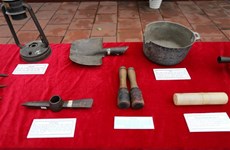Urban metro project earns safety and environmental certification
Thirty trains and other related components of Hanoi’s Cat Linh-Ha Dong urban railway have been completely assessed and obtained a certification for technical safety and environmental protection.
 A train runs on a section of Hanoi’s Cat Linh-Ha Dong urban railway project (Photo: VNA)
A train runs on a section of Hanoi’s Cat Linh-Ha Dong urban railway project (Photo: VNA)Hanoi (VNA) – Thirty trains and other related components of Hanoi’s Cat Linh-Ha Dong urban railway have been completely assessed and obtained a certification for technical safety and environmental protection.
The assessment, carried out by the Vietnam Register Authority under the Ministry of Transport, inspected an actual composition of each of the train’s equipment and components (in both idle and moving state) and checked them against the approved planning and national standards on imported rail components. By passing the technical standards verification, the vehicles have been certified to be operated.
The inspection is in line with the national standard, examining 23 items in idle and electricity-powered states, said a representative of the authority.
After the independent French consulting firm Apave-Certifier-Tricc consortium finished their assessment, the Vietnam Register Authority would have a final verification and issue certification proving the safety of the whole system before the metro project can commence official operations.
Safety assessment includes reliability, readiness, serviceability and safety of vehicle system, train control signaling, plans to evacuate passengers in cases of emergency (on the elevated rail lines and in the stations), smoke and heat management systems and ventilation inside tunnels, electricity compatibility, system integration, test operations, and safety controls.
The certification announcement came four days after the project started whole-system test runs on December 12 lasting through the end of 2020, eyeing commercial operations by March 2021.
During the 20-day trial, every day there will be a total of 287 train journeys, running from 5am to 11pm from Cat Linh in Ba Dinh district to Ha Dong district.
Centrally controlled by a centre placed at the Ha Dong Depot, the railway is set to operate trains with a frequency of every 6 to 7 minutes, which can be shortened to 2 to 3 minutes during rush hours.
During the test run, the trains will run from 5am to 11pm every day, with nine trains operated in rush hour compared to the normal six.
Over 100 personnel from the engineering – procurement – construction (EPC) contractor of the project – the China Railway Sixth Group Co. Ltd, and about 10 experts from the French consulting firm Apave-Certifier-Tricc consortium have been mobilised for the trial run.
After the trial, if meeting all technical requirements, the project will be handed over to the Hanoi authorities, the to the Hanoi Metropolitan Railway Management Board to manage and run.
According to the design, the Cat Linh-Ha Dong urban metro project has a mainline of more than 13km elevated rail line, 12 stations and 13 trains.
Each train has four cars, capable of carrying more than 900 people, with the design speed of 80km per hour but the commercial run’s speed would be capped at an average of 35km per hour.
Earlier, at the meeting of government permanent members on the implementation of the Hanoi urban railway projects, Minister of Transport Nguyen Van The pledged the project would enter commercial operations in the first quarter of 2021, four years after the original finishing date./.
| The project, which commenced in October 2011, has suffered numerous setbacks and delays. The railway, funded with China’s official development assistance to Vietnam, has a total investment capital of approximately 886 million USD after several adjustments. Most recently, hundreds of Chinese technicians and experts have been unable to leave China or enter Vietnam to work on the project due to border closure policies in place in the previous months. The Hanoi People’s Committee has announced the price of the tickets for the Cat Linh-Ha Dong metro, with the lowest one being 8,000 VND for a trip and 30,000 VND for a day pass. A month pass for a common passenger is priced 200,000 VND. |













